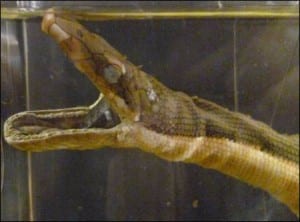Specimen of the Week: Week Sixty-One
By Emma-Louise Nicholls, on 10 December 2012
 You think you know a guy and then he suprises you. Friend, relative, partner… no matter how long you’ve known someone for, they can always despise a shirt you thought they’d go nuts over or express how much they hate Christmas cake in a hereto unbeknown festive culinary revelation. I thought I knew the group of animals to which this week’s specimen belongs, very well. In fact, I’d say most, if not all people have some sort of knowledge base on this group. And yet, here, hidden behind other specimens on a crowded shelf of treats in a Museum display case, I discovered a gem of a species of this well-known group. This week’s Specimen of the Week is…
You think you know a guy and then he suprises you. Friend, relative, partner… no matter how long you’ve known someone for, they can always despise a shirt you thought they’d go nuts over or express how much they hate Christmas cake in a hereto unbeknown festive culinary revelation. I thought I knew the group of animals to which this week’s specimen belongs, very well. In fact, I’d say most, if not all people have some sort of knowledge base on this group. And yet, here, hidden behind other specimens on a crowded shelf of treats in a Museum display case, I discovered a gem of a species of this well-known group. This week’s Specimen of the Week is…
**The yellow-bellied sea snake**
1) The yellow-bellied sea snake is the biggest water lover of all marine snake species, living far from coasts and reefs. In technical jargony speak, it is the most pelagic sea snake. Spotting one can therefore be like looking for a needle in a field of haystacks, as they live in the open ocean. There was one example of a yellow-bellied sea snake turning up in a mangrove swamp which inevitably led scientists, searching for the next biological discovery to boost their career, to suggest that this species may occasionally occur in inter-tidal habitats. However, it’s more likely in my opinion, given the lack of other evidence, that this one individual ended up there by accident due to incident or injury. Perhaps it was off on an adventure, trying to stand out in the crowd, escape the daily grind, and make it’s way in the big wide world? I wonder if they found it carrying a small stick on its shoulder with a red handkerchief full of food hanging from it.
2) The yellow-bellied sea snake is actually a gorgeous looking beast. Check these out. Its back is an exotic purpley-black colour whilst its under surface is, literally bright, yellow. Did you guess already that it had a yellow belly? What gave it away? The tip of the yellow-bellied sea snake’s tail is slightly flattened to serve as a rudder and sports a fetching polka-dot pattern of large purple-black spots on a yellow background.
3) Unfortunately for me, and any other London based someone who fancies swimming off to search for a sea-snake shaped needle in an ocean shaped hay stack, this species of sea snake is not found in the UK. Shockingly. It is quite widespread though. It can be found in the tropical areas of the Pacific and Indian Oceans. Finnicky about temperature, they don’t get out of bed for less than 18º C in the morning, and give up over 20º C. The water column is split into isotherms which are layers of different temperatures of water. The yellow-bellied sea snake only occurs in the isotherm of between 18 and 20º C.
4) Fussy about temperature, it should come as no surprise that it is also fussy about dinnertime. The yellow-bellied sea snake preys solely upon fish. Actually, ‘fish’ is somewhat of a large group so I guess it’s not that fussy. It hunts using super spectacular, hugely dramatic, ambush techniques. Essentially, it lies very, very still and makes out it is a piece of dead wood. Albeit bright yellow with purple spots. Clearly fish are not very clever. Little fish try to take shelter below the snake’s body, thinking it is detritus. This method of hunting means that the snake can only forage to a depth of around 2 m and subsequently lives between 0 and 10 m from the surface. The yellow-bellied sea snake has hollow fangs through which it injects its super duper prey-paralysing uber venom.
5) The yellow-bellied sea snake frequently gathers around floating debris in huge numbers, in fact several thousand have been observed in a few such gatherings. However, scientists are unsure as to whether the snakes purposefully swim to the debris masses, or if they are passively carried there. I chose to believe that they purposefully flock to certain areas in a Woodstock style annual pilgrimage, on preordained dates according to clan name. Probably not though. Despite the large numbers present, there doesn’t appear to be any evidence of mating taking place. Not that sort of social occasion… no car keys in a bowl. The snakes seem content to just feed and clean. The yellow-bellied sea snake cleans itself by tying a knot in its tail and then running it up its body using its muscles. This literally rubs off parasites, such as barnacles and algae. So cool
Emma-Louise Nicholls is the Museum Assistant at the Grant Museum of Zoology
 Close
Close



